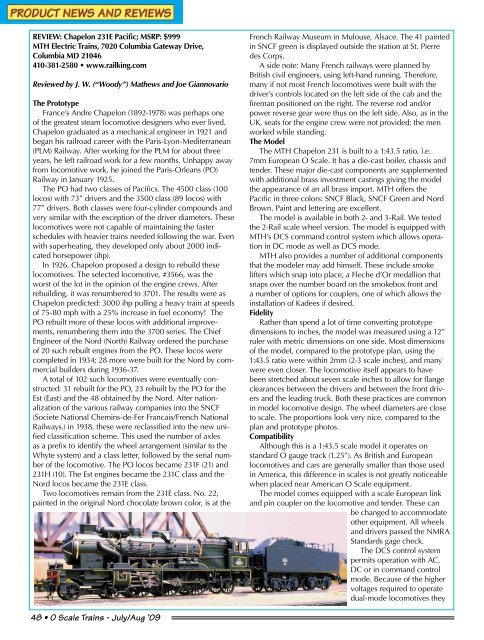Download - O Scale Trains Magazine Online
Download - O Scale Trains Magazine Online
Download - O Scale Trains Magazine Online
- No tags were found...
You also want an ePaper? Increase the reach of your titles
YUMPU automatically turns print PDFs into web optimized ePapers that Google loves.
REVIEW: Chapelon 231E Pacific; MSRP: $999MTH Electric <strong>Trains</strong>, 7020 Columbia Gateway Drive,Columbia MD 21046410-381-2580 • www.railking.comReviewed by J. W. (“Woody”) Mathews and Joe GiannovarioThe PrototypeFrance’s Andre Chapelon (1892-1978) was perhaps oneof the greatest steam locomotive designers who ever lived.Chapelon graduated as a mechanical engineer in 1921 andbegan his railroad career with the Paris-Lyon-Mediterranean(PLM) Railway. After working for the PLM for about threeyears, he left railroad work for a few months. Unhappy awayfrom locomotive work, he joined the Paris-Orleans (PO)Railway in January 1925.The PO had two classes of Pacifics. The 4500 class (100locos) with 73” drivers and the 3500 class (89 locos) with77” drivers. Both classes were four-cylinder compounds andvery similar with the exception of the driver diameters. Theselocomotives were not capable of maintaining the fasterschedules with heavier trains needed following the war. Evenwith superheating, they developed only about 2000 indicatedhorsepower (ihp).In 1926, Chapelon proposed a design to rebuild theselocomotives. The selected locomotive, #3566, was theworst of the lot in the opinion of the engine crews. Afterrebuilding, it was renumbered to 3701. The results were asChapelon predicted: 3000 ihp pulling a heavy train at speedsof 75-80 mph with a 25% increase in fuel economy! ThePO rebuilt more of these locos with additional improvements,renumbering them into the 3700 series. The ChiefEngineer of the Nord (North) Railway ordered the purchaseof 20 such rebuilt engines from the PO. These locos werecompleted in 1934; 28 more were built for the Nord by commercialbuilders during 1936-37.A total of 102 such locomotives were eventually constructed:31 rebuilt for the PO, 23 rebuilt by the PO for theEst (East) and the 48 obtained by the Nord. After nationalizationof the various railway companies into the SNCF(Societe National Chemins-de-Fer Francais/French NationalRailways.) in 1938, these were reclassified into the new unifiedclassification scheme. This used the number of axlesas a prefix to identify the wheel arrangement (similar to theWhyte system) and a class letter, followed by the serial numberof the locomotive. The PO locos became 231F (21) and231H (10). The Est engines became the 231C class and theNord locos became the 231E class.Two locomotives remain from the 231E class. No. 22,painted in the original Nord chocolate brown color, is at theFrench Railway Museum in Mulouse, Alsace. The 41 paintedin SNCF green is displayed outside the station at St. Pierredes Corps.A side note: Many French railways were planned byBritish civil engineers, using left-hand running. Therefore,many if not most French locomotives were built with thedriver’s controls located on the left side of the cab and thefireman positioned on the right. The reverse rod and/orpower reverse gear were thus on the left side. Also, as in theUK, seats for the engine crew were not provided; the menworked while standing.The ModelThe MTH Chapelon 231 is built to a 1:43.5 ratio, i.e.7mm European O <strong>Scale</strong>. It has a die-cast boiler, chassis andtender. These major die-cast components are supplementedwith additional brass investment castings giving the modelthe appearance of an all brass import. MTH offers thePacific in three colors: SNCF Black, SNCF Green and NordBrown. Paint and lettering are excellent.The model is available in both 2- and 3-Rail. We testedthe 2-Rail scale wheel version. The model is equipped withMTH’s DCS command control system which allows operationin DC mode as well as DCS mode.MTH also provides a number of additional componentsthat the modeler may add himself. These include smokelifters which snap into place, a Fleche d’Or medallion thatsnaps over the number board on the smokebox front anda number of options for couplers, one of which allows theinstallation of Kadees if desired.FidelityRather than spend a lot of time converting prototypedimensions to inches, the model was measured using a 12”ruler with metric dimensions on one side. Most dimensionsof the model, compared to the prototype plan, using the1:43.5 ratio were within 2mm (2-3 scale inches), and manywere even closer. The locomotive itself appears to havebeen stretched about seven scale inches to allow for flangeclearances between the drivers and between the front driversand the leading truck. Both these practices are commonin model locomotive design. The wheel diameters are closeto scale. The proportions look very nice, compared to theplan and prototype photos.CompatibilityAlthough this is a 1:43.5 scale model it operates onstandard O gauge track (1.25”). As British and Europeanlocomotives and cars are generally smaller than those usedin America, this difference in scales is not greatly noticeablewhen placed near American O <strong>Scale</strong> equipment.The model comes equipped with a scale European linkand pin coupler on the locomotive and tender. These canbe changed to accommodateother equipment. All wheelsand drivers passed the NMRAStandards gage check.The DCS control systempermits operation with AC,DC or in command controlmode. Because of the highervoltages required to operatedual-mode locomotives they48 • O <strong>Scale</strong> <strong>Trains</strong> - July/Aug ’09
















